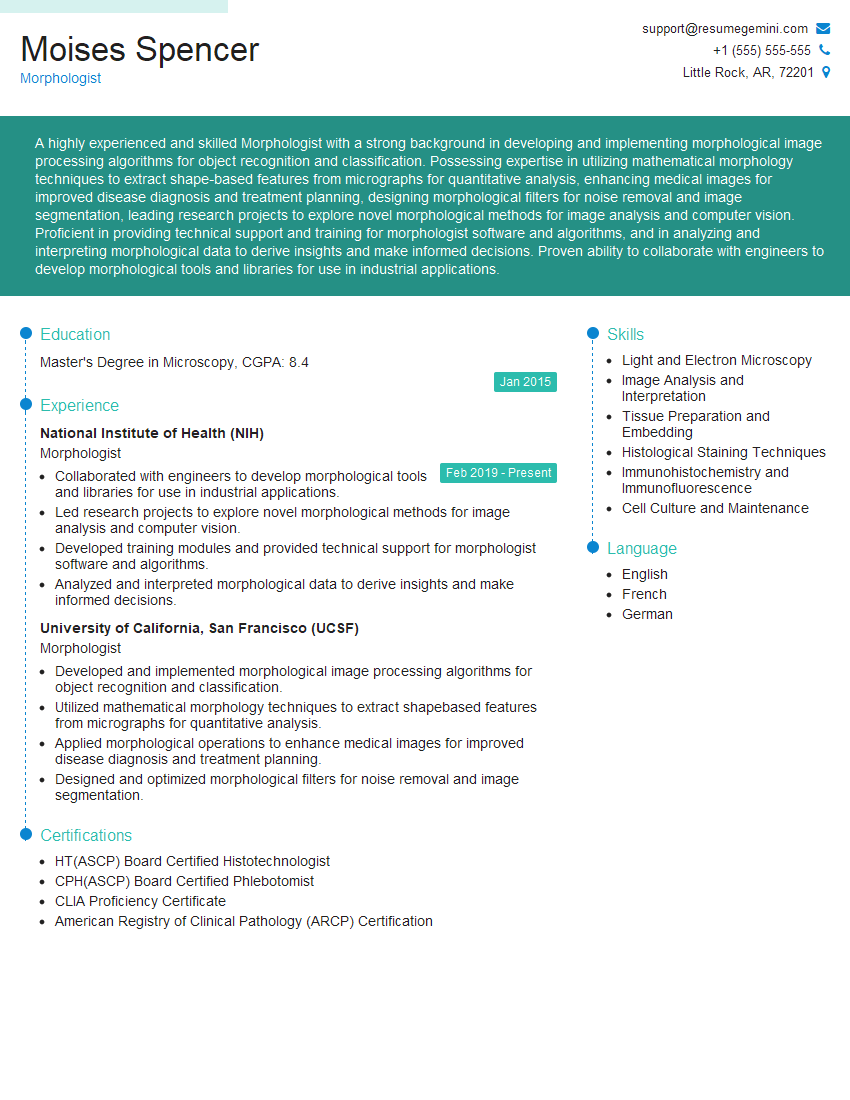Are you a seasoned Morphologist seeking a new career path? Discover our professionally built Morphologist Resume Template. This time-saving tool provides a solid foundation for your job search. Simply click “Edit Resume” to customize it with your unique experiences and achievements. Customize fonts and colors to match your personal style and increase your chances of landing your dream job. Explore more Resume Templates for additional options.

Moises Spencer
Morphologist
Summary
A highly experienced and skilled Morphologist with a strong background in developing and implementing morphological image processing algorithms for object recognition and classification. Possessing expertise in utilizing mathematical morphology techniques to extract shape-based features from micrographs for quantitative analysis, enhancing medical images for improved disease diagnosis and treatment planning, designing morphological filters for noise removal and image segmentation, leading research projects to explore novel morphological methods for image analysis and computer vision. Proficient in providing technical support and training for morphologist software and algorithms, and in analyzing and interpreting morphological data to derive insights and make informed decisions. Proven ability to collaborate with engineers to develop morphological tools and libraries for use in industrial applications.
Education
Master’s Degree in Microscopy
January 2015
Skills
- Light and Electron Microscopy
- Image Analysis and Interpretation
- Tissue Preparation and Embedding
- Histological Staining Techniques
- Immunohistochemistry and Immunofluorescence
- Cell Culture and Maintenance
Work Experience
Morphologist
- Collaborated with engineers to develop morphological tools and libraries for use in industrial applications.
- Led research projects to explore novel morphological methods for image analysis and computer vision.
- Developed training modules and provided technical support for morphologist software and algorithms.
- Analyzed and interpreted morphological data to derive insights and make informed decisions.
Morphologist
- Developed and implemented morphological image processing algorithms for object recognition and classification.
- Utilized mathematical morphology techniques to extract shapebased features from micrographs for quantitative analysis.
- Applied morphological operations to enhance medical images for improved disease diagnosis and treatment planning.
- Designed and optimized morphological filters for noise removal and image segmentation.
Certificates
- HT(ASCP) Board Certified Histotechnologist
- CPH(ASCP) Board Certified Phlebotomist
- CLIA Proficiency Certificate
- American Registry of Clinical Pathology (ARCP) Certification
Languages
- English
- French
- German
Career Expert Tips:
- Select the ideal resume template to showcase your professional experience effectively.
- Master the art of resume writing to highlight your unique qualifications and achievements.
- Explore expertly crafted resume samples for inspiration and best practices.
- Build your best resume for free this new year with ResumeGemini. Enjoy exclusive discounts on ATS optimized resume templates.
How To Write Resume For Morphologist
Quantify your accomplishments:
Use numbers and data to demonstrate the impact of your work. For example, ‘Developed a morphological algorithm that improved object recognition accuracy by 15%.’Highlight your transferable skills:
Emphasize skills that are relevant to other industries, such as data analysis, problem-solving, and communication.Showcase your expertise:
Include specific examples of projects where you used your morphological skills to solve complex problems.Tailor your resume:
Customize your resume to each job application, highlighting the skills and experience that are most relevant to the specific role.
Essential Experience Highlights for a Strong Morphologist Resume
- Developed and implemented morphological image processing algorithms for object recognition and classification.
- Utilized mathematical morphology techniques to extract shape-based features from micrographs for quantitative analysis.
- Applied morphological operations to enhance medical images for improved disease diagnosis and treatment planning.
- Designed and optimized morphological filters for noise removal and image segmentation.
- Collaborated with engineers to develop morphological tools and libraries for use in industrial applications.
- Led research projects to explore novel morphological methods for image analysis and computer vision.
- Developed training modules and provided technical support for morphologist software and algorithms.
Frequently Asked Questions (FAQ’s) For Morphologist
What is the role of a Morphologist?
Morphologists are responsible for studying the structure and form of cells and tissues. They use a variety of techniques, including light and electron microscopy, to examine the microscopic structure of biological samples.
What are the different types of microscopy used in morphology?
The two main types of microscopy used in morphology are light microscopy and electron microscopy. Light microscopy uses visible light to create images of cells and tissues, while electron microscopy uses a beam of electrons to create images of cells and tissues at a much higher resolution.
What are the different techniques used in morphology?
Morphologists use a variety of techniques to study the structure and form of cells and tissues. These techniques include light and electron microscopy, histology, histochemistry, and immunohistochemistry.
What are the applications of morphology?
Morphology is used in a variety of applications, including medical diagnosis, drug discovery, and forensic science.
What are the career opportunities for Morphologists?
Morphologists can work in a variety of settings, including universities, hospitals, and research institutes. They can also work in the pharmaceutical industry or in forensic science.
What are the challenges facing Morphologists?
One of the challenges facing morphologists is the development of new techniques to study the structure and form of cells and tissues at a higher resolution. Another challenge is the need to develop new methods to analyze the large amounts of data that are generated by morphological studies.